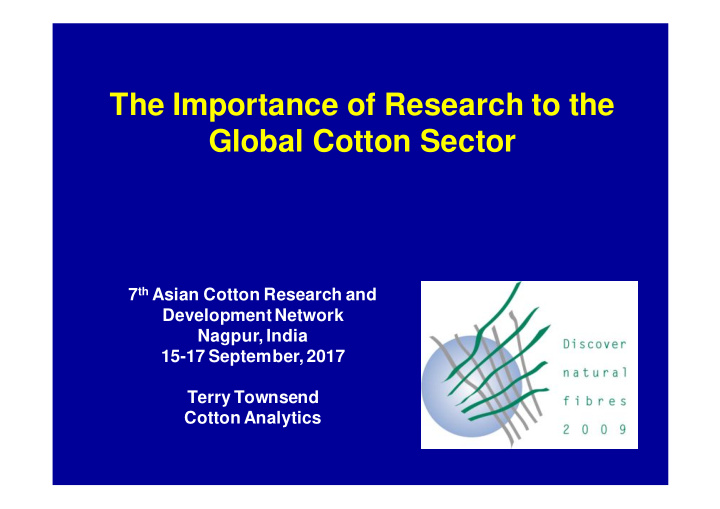



The Importance of Research to the Global Cotton Sector 7 th Asian Cotton Research and Development Network Nagpur, India 15-17 September, 2017 Terry Townsend Cotton Analytics
Natural Fibre Production, 2016 30 MM Tons Bastfibres, other Abaca Cotton Lint Coir Fibre crops not specified elsew here Flax fibre and tow, ex scutching mill Hemp tow waste Jute, Kenaf & Allied Fibres Kapok fibre Ramie Sisal, Henequen and sim ilar hard fibers Silk, raw Wool, clean Other animal, greasy w eight*
Value of Natural Fibre Production, 2016 $50 Billion Cotton Wool Jute Other
Population and Income Growth Do not guarantee Market Relevance
They must do things better They must do things differently
WORLD WOOL PRODUCTION, MMT Million tons 2.0 1.5 1.0 0.5 1960 1970 1980 1990 2000 2010
MARKET SHARE OF COTTON % 70 Average 1960-1979 60 50 Average 1980-1999 40 30 Average 2000-2016 20 10 0
Fiber M ill Use, M illion Tons 110 Cotton Polyester Other 90 70 50 30 10 1980/ 81 1990/ 91 2000/ 01 2010/ 11 2020/ 21
Partnership for Sustainable Textiles Cotton is Destructive & Exploitative
World Population, millions 10,000 8,000 M odern Agriculture 6,000 4,000 2,000 Organic Agriculture 0 0 300 600 900 1200 1500 1800 Years, AD
I nnovation took cotton from 1000 200 kgs/ ha to 800 kgs/ ha 900 Mendelian breeding 800 Mechanization 700 Fertilizers Pesticides 600 Biotechnology 500 400 300 200 100 Zero gain per year 0
WORLD COTTON AREA Million Hectares 80 65 50 35 20 50/51 60/61 70/71 80/81 90/91 00/01 10/11
WORLD COTTON YIELDS Kilograms per Hectare 800 y = 8.7x + 202.24 650 R² = 0.954 500 350 200 50/ 51 60/ 61 70/ 71 80/ 81 90/ 91 00/ 01 10/ 11 20/ 21
World Cotton Mill Use 1938/39 12% 28% 11% 9% 24% 12% 1% 3%
World Cotton Mill Use 2016/17 2% 1% 36 % 7% 5% 42% 1% 5%
World Cotton Mill Use 2026/27 5% 4% 29% 8% 8% 35% 3% 8%
The Importance of Research to the Global Cotton Sector Cotton Must Compete: Technology is Key
Recommend
More recommend